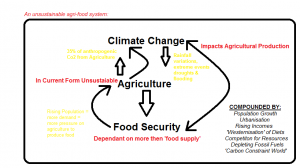Climate Change, Agriculture and Food Nutritional Security (CCAFS) 
Climate change impacts agriculture and consequently food nutritional security. Moreover, agriculture impacts climate change, contributing 35% of anthropogenic CO2 [1] thereby constraining the ability of agriculture to meet projected demand to 2050 [2]. Agricultural production therefore finds itself under increasing pressure to meet the food demands of a growing population as well as reduce its impact on the landscape, environment and climate
The convergence of a rising world population, expected to surpass 9 billion by 2050, and the onset of climate change means humanity is facing perhaps its greatest challenge [3]. Food production both relies on and alters the very biological and material world on which it relies [4]. Agriculture is responsible for 47% of total anthropogenic methane emissions and 58% of nitrous oxide [5]. Moreover, livestock production is the largest contributor to agriculture’s carbon footprint, estimated to account for 14% of anthropogenic emissions, with animal feed production/processing and enteric fermentation accounting for 45% and 39% respectively [6].
Furthermore, present day farming practices have serious effects beyond contributing to greenhouse gases (GHG’s). Of all the land used for agriculture, 80% is given over to livestock production and is linked with mass deforestation; 3 million hectares per year, 70% of which is occurring in Latin America [7]. Food production also uses up to 70% of all freshwater [8], with livestock contributing most to the sectors associated with water pollution [9, 10]. In addition, modern agricultural methods are implicated in biodiversity loss, soil depletion and degradation [2, 5, 6, 11] such that some [4, 12] now suggest that agriculture has surpassed the environmental limits in which we live. All of these factors threaten the world’s ability to produce food into the future [13].
 Climate change also directly hinders the ability of agriculture to meet future food demands. It jeopardises the natural resources, water, biodiversity and soils on which agriculture relies and as such may see a material geographical shift in the production of soft commodities [5]. Moreover, climate change will result in deteriorating yields in some crops [2, 7, 14] and create harsher and more unpredictable conditions for producing agricultural commodities.
Climate change also directly hinders the ability of agriculture to meet future food demands. It jeopardises the natural resources, water, biodiversity and soils on which agriculture relies and as such may see a material geographical shift in the production of soft commodities [5]. Moreover, climate change will result in deteriorating yields in some crops [2, 7, 14] and create harsher and more unpredictable conditions for producing agricultural commodities.
Consequently, extensive and wide ranging research into how we can develop solutions to the ‘CCAFS’ problem is underway, covering areas such as sustainable intensification, closing the yield gaps and climate-smart agriculture. The issue is, more often than not , conceived as issues of production [9]. However, it is the combination of both the production and subsequent consumption that makes food the biggest utilizer of natural resources [7]. If we are to meet future demands in addition to reducing agriculture’s environmental impact, then demand-side efficiency must also be addressed.
References (numbered) link: http://www.plantagbiosciences.org/people/sinead-moran/bibliography/

 Climate change also directly hinders the ability of agriculture to meet future food demands. It jeopardises the natural resources, water, biodiversity and soils on which agriculture relies and as such may see a material geographical shift in the production of soft commodities [5]. Moreover, climate change will result in deteriorating yields in some crops [2, 7, 14] and create harsher and more unpredictable conditions for producing agricultural commodities.
Climate change also directly hinders the ability of agriculture to meet future food demands. It jeopardises the natural resources, water, biodiversity and soils on which agriculture relies and as such may see a material geographical shift in the production of soft commodities [5]. Moreover, climate change will result in deteriorating yields in some crops [2, 7, 14] and create harsher and more unpredictable conditions for producing agricultural commodities.